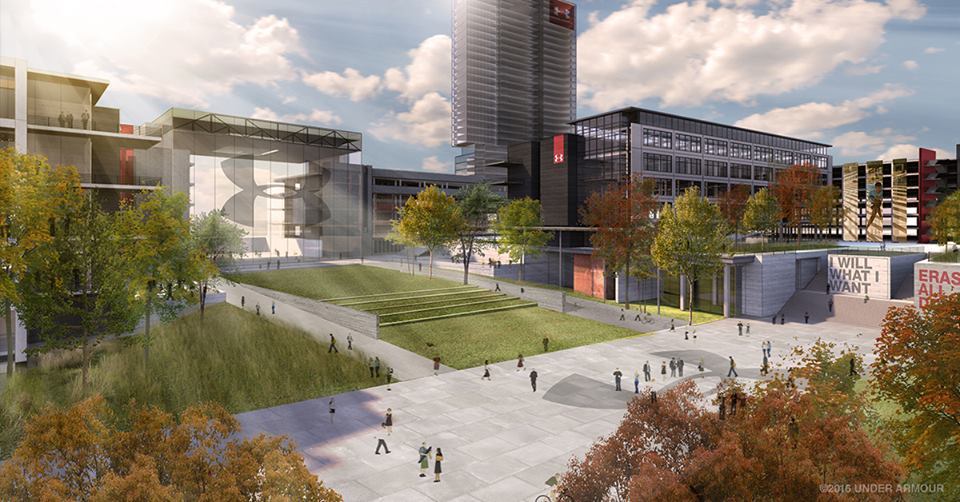
Update, Friday 10:40 a.m. — At Thursday evening’s City Council committee meeting only two of the three Port Covington-related bills passed before Carl Stokes, chairman of the economic development committee unexpectedly called a recess. Stokes told The Baltimore Sun that he believed the public had not been given enough time to review the community benefits agreement that was part of the Sagamore Development Company’s negotiation with city and community leaders. Stokes also expressed concern that the agreement did not adequately protect school funding, which could possibly be affected by the financing and property tax agreement. Stokes said he expected to bring the third bill back before the committee next week for a vote.
Mayor Stephanie Rawlings-Blake, City Council President Bernard C. “Jack” Young, neighborhood leaders, clergy, and representatives from Sagamore Development announced Thursday what elected officials called a precedent-setting community benefits commitment as part of the proposed Port Covington development plan.
Reached after 10 days of intensive negotiation, the agreement in principal includes more than $100 million in community commitments for Baltimore by Sagamore—the development arm of Kevin Plank and Under Armour.
The deal also increases and solidifies the affordable housing, workforce development, minority business, and local hiring commitments for the massive project.
The memorandum of understanding, according to a statement from Sagamore officials, was the result of work with Baltimore City officials, the coalition known as the South Baltimore Six—representing the communities of Westport, Cherry Hill, Lakeland, Brooklyn, Curtis Bay, Mount Winans—and Baltimoreans United in Leadership Development (BUILD). It also reflects, Sagamore officials said, cumulative meetings with dozens of other groups, including workforce training providers, faith leaders, housing and education advocates, and neighborhood activists.
“Thanks to the historic agreement reached between the City, developer, and community members, Baltimore’s workforce is positioned to benefit from employment opportunities that will stretch across a generation,” Young said at an afternoon press conference at the Sagamore-owned City Garage in South Baltimore. “In addition to providing meaningful jobs, the benefits agreement pumps tens of millions of dollars into programs to support workforce development initiatives, education programs, college scholarships, and improvements to recreation facilities.
“Port Covington will serve as a true model for economic development throughout our region and nation,” Young added.
Pending final vote by the City Council, the agreement would open the door for Sagamore to use up to $660 million in taxpayer-backed bonds—known as TIFs—to fund infrastructure improvements, including roads, sewage and water lines, as well other utilities and public amenities. Sagamore will be required to pay back the taxpayer-backed bonds with future property taxes.
The City Council’s Taxation, Finance and Economic Development committee is now expected to approve the authorization of tax increment financing package at its scheduled hearing this evening.
Councilman Eric Costello, whose South Baltimore district includes the Port Covington area, said with committee approval this evening, the financing and development proposal is likely to come before the entire City Council for its first vote Monday.
In an open letter to The Baltimore Sun this week, Plank wrote that Sagamore is planning to spend $5.5 billion to redevelop land in the Port Covington area, creating a mixed-use community as well as a 50-acre campus for the growing athletic apparel giant.
Plank also announced the donation of $1 million to Baltimore Catholic schools last week.
The citywide benefits commitment by Sagamore includes, among other items:
• $39 million in direct benefits to the six surrounding communities of Port Covington—Brooklyn, Curtis Bay, Westport, Cherry Hill, Lakeland, and Mount Winans
• $55 million in other direct citywide benefits including workforce development initiatives, education programs, college scholarships, recreation facilities and youth summer jobs
• $6.5 million in incremental costs for prevailing wages agreed to by Sagamore
“The citywide community benefits commitment sets forth an unprecedented agreement to grow Baltimore, and ensures that Port Covington’s development is a success for surrounding communities and our city at-large,” Rawlings-Blake said.
Approximately $20 million of the benefits agreement is projected to be paid out in the first five years following TIF authorization, according to Sagamore.
In terms of local hiring, Sagamore agreed to a mandate that 30 percent of all on-site infrastructure and construction work be performed by Baltimore City residents. Additionally, 51 percent of all new, non-construction labor is required to go to Baltimore City residents.
In relation to inclusionary housing, Sagamore has doubled its affordable housing commitment, agreeing to provide income-restricted residential units equal to 20 percent of all residential units at Port Covington, including units for very-low income households with incomes at or below 30 percent of area median income.
In their remarks at the press conference, Miles and another BUILD leader, Rev. Glenna Huber, praised Sagamore representatives for their willingness to listen to neighborhood and city activists, while developing relationships with local communities. Huber said the agreement marked “a brand new day” and even sang a few lines from the ’70s song by the same name before addressing the press conference.
“They realized we were serious about negotiations—that we weren’t looking for something to benefit BUILD, but would benefit the citizens of Baltimore and started listening,” Miles said. “The city hadn’t demanded enough. Sagamore said so themselves.”
